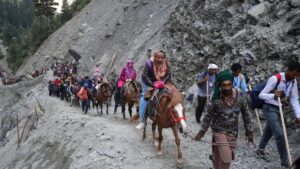Table of Contents
1st Delta Ranking Of ABP
Context: NITI Aayog released the 1st Delta Ranking of the Aspirational Blocks Program (ABP).
What are Delta Rankings?
Delta Rankings evaluate the progressive advancements of aspirational districts in various development sectors, including health and nutrition, education, agricultural and water resources, financial inclusion, and essential infrastructure.
We’re now on WhatsApp. Click to Join
Key Highlights of Delta Ranking of Aspirational Blocks program (ABP)
- The Delta Rankings were unveiled during a virtual event hosted by NITI Aayog, attended by representatives from 329 districts and 500 aspirational blocks nationwide.
- This marked the inaugural instance of block-level rankings being determined under the Aspirational Blocks Programme.
- Top Performers
- First position: Tiriyani Kumuram Bheem block of Asifabad, Telangana.
- Second position: Kaushambi block of Kaushambi district of Uttar Pradesh.
- Ranking Criteria: The blocks’ rankings were determined based on their performance and progress in Key Performance Indicators (KPIs) as of June 2023.
- Wall of Honor: NITI Aayog has created a dedicated Wall of Honor to showcase the leading performers in the Aspirational Blocks Programme (ABP) and Aspirational Districts Programme (ADP).
- This Wall of Honor will feature the names of the highest achievers in both the ABP and ADP.
- Vision for a Developed India: The Wall of Fame highlights the key milestones of the Aspirational Blocks Programme and Aspirational Districts Programme with a vision to create Viksit Bharat by 2047.
- Illustrating Social Impact: The Wall of Honor also aims to narrate the transformative impact these programmes have had in terms of empowering communities, enhancing livelihoods, and bringing about significant societal changes.
|
Note |
| In addition to the ABP rankings, the statement also revealed the rankings for the Aspirational District Programme (ADP) for October 2023. Rayagada in Odisha secured the first position, with Jamui in Bihar coming in second. |
Geographical Zones Delta Ranking
| Zone | Geographical Area | 1st Position | 2nd Position |
| Zone 1 | Hilly, North-eastern States, Islands | Amri, West Karbi Anglong, Assam | Ngopa, Saitual, Mizoram |
| Zone 2 | Northern Indian States | Harraiya, Basti, Uttar Pradesh | Virno, Ghazipur, Uttar Pradesh |
| Zone 3 | Southern States | Maski, Raichur, Karnataka | Narnoor, Adilabad, Telangana |
| Zone 4 | Western India | Sironcha, Gadchiroli, Maharashtra | Aheri, Gadchiroli, Maharashtra |
| Zone 5 | Central India | Tirla, Dhar District, Madhya Pradesh | Pati, Barwani District, Madhya Pradesh |
| Zone 6 | Eastern India | Andar, Siwan, Bihar | Ramgarh, Dumka, Jharkhand |
Global Status Report on Road Safety 2023
Context: Recently, the World Health Organization (WHO) released a report titled The Global Status Report on Road Safety 2023.
Key Highlights of the Report
- Global Trend in Road Traffic Deaths: From 2010 to 2021, there was a global reduction of 5% in road traffic fatalities, with an annual death toll of approximately 1.19 million.
- Road traffic accidents continue to be the foremost cause of death among children and youth aged 5–29 years.
- Reductions Reported by Several Countries: Of the United Nations member states, 108 reported decreases in road traffic fatalities during this period.
- However, India experienced a 15% rise, with fatalities increasing from 134,000 in 2010 to 154,000 in 2021.
- Notable Achievements in Road Safety: A group of ten countries, including Belarus, Brunei Darussalam, Denmark, Japan, Lithuania, Norway, Russian Federation, Trinidad and Tobago, United Arab Emirates, and Venezuela, managed to cut road traffic deaths by more than half.
- Additionally, 35 countries recorded significant progress, decreasing deaths by 30% to 50%.
- Geographical Distribution of Traffic Deaths: The distribution of road traffic fatalities varied by region:
- 28% in the WHO South-East Asia Region,
- 25% in the Western Pacific Region,
- 19% in the African Region,
- 12% in the Americas,
- 11% in the Eastern Mediterranean Region, and
- 5% in the European Region.
- Disproportionate Impact on Lower-Income Countries: Despite possessing only 1% of the world’s motor vehicles, low- and middle-income countries accounted for 90% of global road traffic deaths.
- Vulnerability of Certain Road Users: Vulnerable road users comprised 53% of all road traffic fatalities, with pedestrians at 23%, riders of powered two- and three-wheelers at 21%, cyclists at 6%, and users of micro-mobility devices at 3%.
- Pedestrian fatalities increased by 3% to 274,000, and cyclist deaths rose nearly 20% to 71,000 between 2010 and 2021. Meanwhile, fatalities among car and other light 4-wheeled vehicle occupants slightly decreased, representing 30% of global fatalities.
- Safety Standards and Policies: The report reveals a concerning lack of progress in advancing laws and safety standards.
- Only six countries have laws that align with WHO best practices for all major risk factors like speeding, drink-driving, and the use of helmets, seatbelts, and child restraints.
- Key Recommendation: The report emphasises the need for better infrastructure, as nearly 80% of all assessed roads do not meet a minimum 3-star rating for pedestrian safety.
| Initiatives for Road Safety |
Global Initiatives
Initiatives in India
|
Forest Owlet
Context: The endangered Forest Owlet was recorded in the Melghat Tiger Reserve in the Amravati district of Maharashtra.
About Forest Owlet
Taxonomy and Description:
- Scientific Name: Athene Blewitti
- Scientifically described by Allan Octavian Hume in 1873, the Forest Owlet was thought extinct for over a century until its rediscovery in 1997. It is a member of the Athene clade, a group within the typical owl family Strigidae.
- It’s a small (23 cm), stocky bird with a relatively large skull and beak.
- Its distinctive features include a whitish underside, heavily banded wings and tail, fewer and fainter spots on the crown and back compared to the Spotted Owlet, and yellow eyes.
Distribution and Habitat:
- The Forest Owlet is endemic to the forests of Central India, specifically in areas like Maharashtra, Madhya Pradesh, Odisha, Chhattisgarh, and Gujarat.
- Its natural habitat comprises dense to open deciduous forests with specific tree species like Tectona grandis, Lagerstroemia parviflora, Boswellia serrata, and Lannea grandis.
- Nest cavities for the owlet are often found at heights of 5.0–8.0 metres in trees like Soymida febrifuga.
Behaviour and Ecology:
- The Forest Owlet is diurnal, active during the day, particularly in the morning hours. It hunts from perches, waiting for prey like lizards, skinks, rodents, birds, invertebrates, and frogs.
- Its courtship season peaks in January and February, and it exhibits unique vocalisations for different purposes, such as territorial calls, alarm calls, and mating calls.
Conservation Status:
- Classified as endangered by the IUCN, with an estimated population of about 250 mature individuals.
- Endangered, bird endemic to India and placed in Schedule I of the Indian Wildlife (Protection) Act of 1972.
- The species is listed in CITES Appendix I, reflecting its critical conservation status
Threats
- Habitat Destruction: Logging activities, as well as the burning and cutting of trees for firewood and timber, are destroying the roosting and nesting trees vital for the Forest Owlet.
- Encroachment and Habitat Degradation: Agricultural expansion, grazing, and human settlements are encroaching into the Forest Owlet’s habitat, reducing its suitability for the species.
- Infrastructure Development: Projects like the expansion of state and national highways, especially in the Kanha-Pench Corridor, and the construction of minor irrigation dams, pose significant threats to its habitat.
- Predation and Competition: The Forest Owlet is preyed upon by native raptors, which limits its productivity. It also faces competition for nesting cavities, which are in limited supply.
- Hunting and Cultural Practices: Local hunting practices pose a threat, as the owlet and its eggs are sometimes used in local customs, such as making drums.
- Pesticide and Rodenticide Use: The use of pesticides and rodenticides within the owlet’s range, though not fully quantified, potentially poses an additional risk to the species.
- Climate-Related Challenges: Severe drought conditions not only affect the forest directly but also lead to increased human pressures on the owlet’s habitat.
Arctic Report 2023
Context: The year 2023 shattered the record for the warmest summer in the Arctic, and people and ecosystems across the region felt the impact.
Impact Of Global Warming On The Arctic
- Rapid Temperature Rise: The Arctic is experiencing a temperature increase at a rate more than three times faster than the global average, leading to 2023 being the warmest summer recorded in the region.
- Wildfires and Melting Events: Canada has faced significant wildfires, prompting evacuations. Greenland experienced unprecedented warming, with its ice sheet summit undergoing melting events rarely recorded before.
- Elevated Sea Surface Temperatures: Sea surface temperatures in the Barents, Kara, Laptev, and Beaufort seas have risen significantly, being 5 to 7 degrees Celsius higher than normal in August.
- Early Snowmelt: The early melting of winter snow cover in parts of northern Canada has exposed the ground to additional solar heating, exacerbating the warming effect.
- Increased Wildfires: The combination of heat and dry conditions has led to extensive wildfires across Canada, particularly affecting organic matter on and below the surface.
- Water Absorption of Sun’s Rays: The dark open waters absorb solar radiation in the summer, and release heat back into the atmosphere in autumn, further warming the region.
- Changing Wind Patterns and Storm Intensity: There have been noticeable shifts in wind patterns and an increase in the intensity of ocean storms.
- Impact on Indigenous Communities: The cultural practices and food security of Arctic indigenous communities are being severely affected by climate change.
- Changes in Wildlife: The size of Yukon River Chinook has decreased, affecting the region’s food security. Finland is making efforts to restore damaged reindeer habitats.
- Peatlands and Greenhouse Gases: The degradation of peatlands releases greenhouse gases, but maintaining their health is crucial for capturing and storing carbon, mitigating climate change.
| Subsea Permafrost |
Subsea permafrost refers to a type of permafrost located beneath the ocean floor, primarily in the Arctic region. This permafrost is an area of frozen soil rich in organic material.
|
Off Budget Borrowings
Context: The Kerala government has approached the Supreme Court against the Centre imposing a ceiling on the amount it can borrow.
What is Off Budget Borrowing?
Off-budget borrowings by a state government refer to loans taken by its entities, special purpose vehicles, etc., which are expected to eventually be serviced through the state government’s own budget, instead of the cash flows or revenues generated by the borrowing entity.
- Purpose of Off-Budget Borrowings: They are primarily used to fulfill the government’s expenditure needs without reflecting these amounts directly in the central budget.
- This approach allows for financing government expenditures while keeping the debt off the official books.
- Impact on Fiscal Deficit: Since these liabilities are not formally on the government, they are excluded from the national fiscal deficit calculation.
- This helps keep the country’s fiscal deficit within acceptable limits, presenting a more favourable fiscal outlook.
- Methods of Raising Funds: Off-budget borrowings can be raised through various means, including the issuance of bonds by public sector units or implementing agencies, loans from public sector banks, or utilising savings from other funds.
- For instance, a shortfall in the food subsidy bill might be met through a loan from the National Small Savings Fund, or public sector oil marketing companies might be asked to borrow for government projects like the PM Ujjwala Yojana.
- Implications for Fiscal Management: This form of borrowing has significant implications for fiscal transparency and the overall fiscal health of the government’s finances.
- It can lead to fiscal manipulation, as certain expenditures are kept off the official budget, potentially misleading stakeholders about the true fiscal situation.
- Long-term Consequences: While off-budget borrowing may provide short-term relief, it can have long-term consequences.
- The delayed recognition of liabilities can lead to an unexpected surge in fiscal deficits when these are eventually acknowledged in the official accounts, creating fiscal stress.
- Impact on Macroeconomic Stability: Such borrowing can distort fiscal indicators crucial for policy formulation, potentially destabilising the macroeconomic environment.
- Recent Trends:
- Recent trends in off-budget borrowing indicate a widespread practice, particularly in states such as Andhra Pradesh, Telangana, Kerala, Chhattisgarh, and Sikkim.
- The scale of these borrowings has been substantial, with estimates indicating around ₹2.79 trillion in the fiscal year 2020-21 and approximately ₹1.71 trillion in 2021-22.
- Concerns about fiscal transparency and sustainability have been raised by both the 15th Finance Commission and the Comptroller and Auditor General of India (CAG), highlighting the potential issues these borrowings pose to the financial health and transparency of the state’s finances.
Central Government Response Against Off Budget Borrowings
- New Policy Implementation: As of March 2022, the Central Government mandated that off-budget borrowings by states will be included in their regular borrowing limits.
- Effects on State Finances: This policy change has reduced the borrowing capacity of states, leading to financial strains in some regions. It has also sparked protests and threats of legal actions from various states.
- Changes in Off-Budget Borrowings: For the fiscal year 2022-23, off-budget borrowings by states are projected to decrease significantly to around ₹18,499 crore.
- Current Fiscal Status of India: Achieving true fiscal sustainability requires both the central and state governments to align their deficits with the targets set by the Fiscal Responsibility and Budget Management (FRBM) Act.
- FRBM Act’s Deficit Targets: The FRBM Act’s objectives include eliminating the revenue deficit and maintaining a fiscal deficit at 3% of GDP.
- However, projections for the fiscal year 2023-24 indicate that 11 states may experience a revenue deficit.
- The combined fiscal deficit of all states is expected to be around 3.1%. The Central Government’s revenue and fiscal deficits are forecasted to be 2.9% and 5.9% of GDP, respectively.


 Operation Shiva 2025: Indian Army’s Ma...
Operation Shiva 2025: Indian Army’s Ma...
 World Youth Skills Day 2025, Theme, Hist...
World Youth Skills Day 2025, Theme, Hist...
 President Murmu Nominates Four Members t...
President Murmu Nominates Four Members t...





















